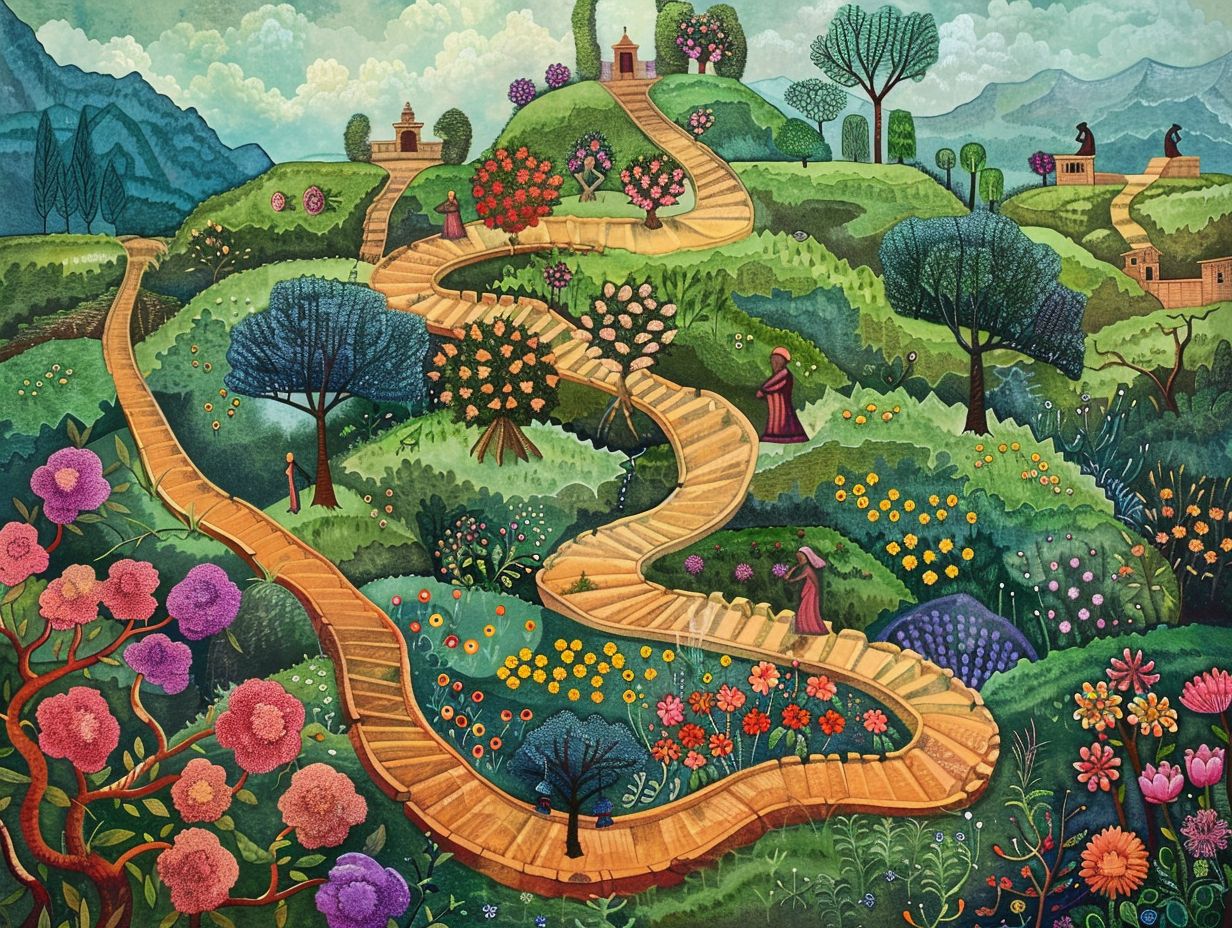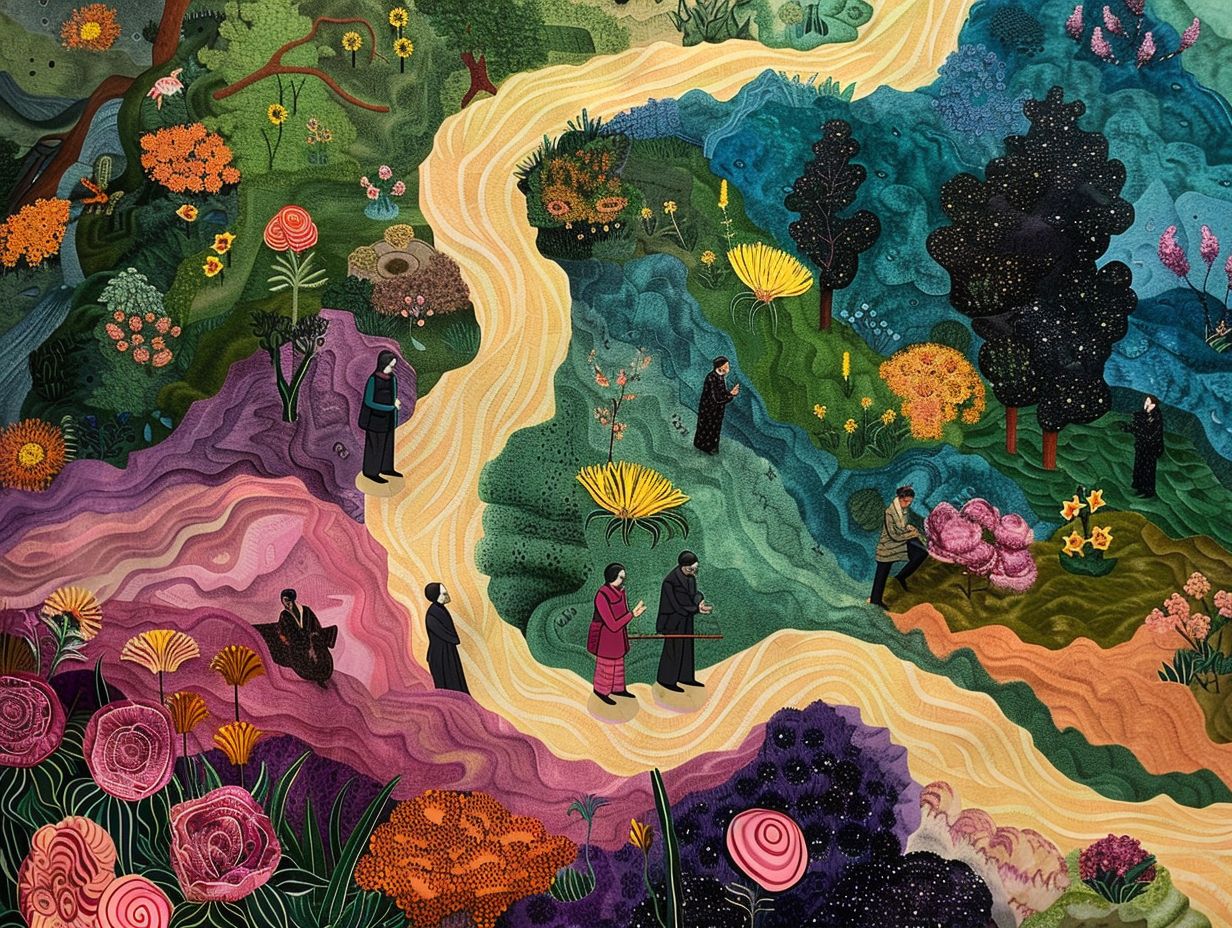Four Sources of Knowledge in Nyaya: Perception, Inference, Comparison, Testimony
Nyaya, an ancient Indian philosophy, presents a captivating examination of the processes through which knowledge is acquired.
At the heart of this philosophical framework lie four critical sources: perception, inference, comparison, and testimony. Each of these sources contributes distinct insights into human understanding of the surrounding world.
This exploration delves into each of these concepts, scrutinizing their definitions, classifications, and interconnections. By uncovering the synergistic dynamics of these sources, one can cultivate perspectives that enrich everyday life, thereby enhancing critical thinking and decision-making skills.
What is Nyaya?

Nyaya, a distinguished school of Indian philosophy, centers on the intricate principles of epistemology, systematically investigating the sources of knowledge, the validity of that knowledge, and the cognitive processes that form the bedrock of human understanding.
Grounded in ancient texts, Nyaya champions critical thinking and philosophical inquiry, offering a comprehensive framework for assessing diverse systems of knowledge. Its doctrines intricately explore the nature of perception, inference, comparison, and testimony, each serving as a unique epistemic method through which individuals acquire and substantiate their beliefs.
As a cornerstone of philosophical discourse, Nyaya aims to distinguish objective truth from subjective experience, thereby enriching the comprehension of cognition and reasoning.
What are the Four Sources of Knowledge in Nyaya?
In Nyaya philosophy, the four primary sources of knowledge perception, inference, comparison, and testimony function as fundamental epistemic methods for the acquisition and evaluation of knowledge.
Each source presents a distinct pathway to understanding, engaging various cognitive processes that contribute to the development of belief systems within the broader context of Indian philosophy.
Perception (pratyaksha) offers direct sensory experience, while inference (anumana) employs logical reasoning to derive conclusions from empirical evidence.
Comparison (upamana) facilitates understanding through analogical reasoning, and testimony (sabda) underscores the significance of authoritative sources in validating knowledge claims.
Collectively, these sources establish a comprehensive framework for epistemic justification and the understanding of reality.
Perception
Perception, referred to as pratyaksha in Nyaya, stands as the foundational source of knowledge, deeply rooted in direct sensory experience that shapes an individual’s understanding of reality.
This epistemic method is essential for acquiring knowledge, enabling individuals to interact with the external world through their senses, thus providing immediate and firsthand information.
The reliability and validity of perceptual knowledge depend on the cognitive processes involved in sensory perception, which can be swayed by cognitive biases and preconceived notions.
Therefore, grasping the nature and limitations of perception becomes critical in assessing the various frameworks of knowledge, as it establishes the groundwork for further epistemic exploration.
What is Perception in Nyaya?
In the realm of Nyaya philosophy, perception (pratyaksha) is articulated as the epistemic value derived from immediate sensory experience, serving as the cornerstone of knowledge acquisition. This foundational source is vital, enabling individuals to observe and interpret their environment, thus initiating the cognitive journey towards understanding reality.
The reliability of perceptual knowledge is rooted in its direct interaction with objects; however, the interpretation of such experiences is contingent upon cognitive processes that can significantly shape how individuals perceive and comprehend their surroundings.
The intricate relationship between sensory experiences and cognitive interpretations invites profound inquiries into the very nature of knowledge. Within the Nyaya framework, the dynamic interplay between one’s perception of an object and the subsequent mental processing is imperative. This entails filtering sensory information through mental constructs molded by prior experiences and knowledge, ultimately influencing the comprehension of perceptual data.
Acknowledging the varying degrees of reliability inherent in sensory input prompts a more profound exploration of how perception informs one s beliefs about the world. By examining these layers, one can gain insight into the nuanced ways in which perception functions both as a mechanism for acquiring knowledge and as a complex process shaped by subjective experiences.
What are the Types of Perception in Nyaya?
Nyaya delineates several types of perception that are crucial in the realm of knowledge acquisition. These categories include direct perception, which stems from immediate sensory experiences, and inferential perception, which entails drawing conclusions based on observed phenomena. Grasping these distinctions within the Nyaya framework is essential for understanding the limitations of perceptual knowledge and acknowledging how various forms contribute to broader systems of knowledge.
Moreover, Nyaya emphasizes a third type known as verbal perception, which arises from the comprehension and interpretation of conveyed information. Each category possesses its own unique characteristics and implications, shaping how individuals discern reality and construct their understanding of the world.
Direct perception is frequently regarded as the most reliable, firmly anchored in firsthand experience, while inferential perception underscores the cognitive processes that follow observation, facilitating deeper insights. Verbal perception, conversely, introduces the subjectivity inherent in language, illuminating how knowledge can be swayed by context and interpretation.
By analyzing these types, one achieves a clearer understanding of the constraints that sensory experiences impose on knowledge acquisition, prompting a critical approach to the interpretation and validation of information.
Inference
Inference, known as anumana in Nyaya philosophy, serves as a pivotal epistemic method, give the power toing individuals to draw conclusions through logical reasoning grounded in premises and observable evidence.
Unlike perception, which is confined to sensory experience, inference engages cognitive processes that enable deductive reasoning and the assessment of knowledge claims. By utilizing indicators and signs, individuals can build a framework of understanding that transcends immediate sensory input, positioning inference as an essential avenue for philosophical exploration and the synthesis of knowledge.
What is Inference in Nyaya?

Inference (anumana) in the Nyaya tradition represents a refined process of logical reasoning, give the power toing individuals to draw conclusions from premises rooted in observation. This epistemic method is pivotal in the assessment of knowledge, enabling individuals to formulate educated guesses and forecasts about their surroundings.
Within this philosophical framework, inference transcends mere abstraction; it serves as a vital tool for validating knowledge claims and facilitating rational discourse.
Employing deductive reasoning, individuals can assess the relationships among premises, ultimately arriving at robust conclusions that enhance their understanding. By meticulously structuring arguments, the Nyaya system fosters clarity and coherence in thought, ensuring that conclusions are drawn thoughtfully rather than impulsively, based on a systematic analysis of evidence.
This method cultivates a deeper engagement with knowledge, urging individuals to critically examine their beliefs and refine their reasoning abilities, thereby bolstering their capacity to navigate the complexities of everyday life.
What are the Types of Inference in Nyaya?
Nyaya articulates a range of inference types, each marked by unique characteristics and applications within the domain of knowledge acquisition. Among these, generalized inference is notable for its ability to apply overarching principles to specific instances, while specific inference focuses on drawing conclusions based on particular observations.
An in-depth examination reveals further categories of inference, including analogical inference, which assesses similarities between known and unknown instances in order to derive conclusions, and causal inference, which scrutinizes the cause-and-effect relationships between events.
These distinctions not only deepen one s philosophical comprehension but also refine analytical thinking, fostering a meticulous approach to reasoning. The effectiveness of these inferential methods in evaluating knowledge is pivotal in intellectual discourse, enabling individuals to construct arguments, grasp complex concepts, and reach well-founded conclusions, thereby ultimately enhancing their cognitive capacities.
Comparison
Comparison, or upamana in Nyaya, functions as an essential epistemic method, facilitating the comprehension of new concepts through the lens of analogical reasoning.
This invaluable source of knowledge give the power tos individuals to explore the intricate relationships between familiar and unfamiliar entities, thereby enhancing cognitive processes and supporting the evaluation of knowledge.
By drawing insightful parallels, comparison cultivates a profound understanding of various categories of knowledge, establishing connections that significantly enrich philosophical discourse and inquiry.
What is Comparison in Nyaya?
In Nyaya, comparison (upamana) is recognized as a sophisticated epistemic method that facilitates understanding through analogical reasoning, deftly drawing connections between known and unknown concepts. This process give the power tos individuals to map their existing knowledge onto new experiences, thereby enriching their cognitive framework and enhancing the evaluation of knowledge claims.
By leveraging the capabilities of comparisons, individuals can articulate and comprehend complex ideas more effectively, significantly enriching their philosophical inquiry.
This analytical mechanism plays a crucial role in shaping reasoning skills, providing a robust framework that enables the identification of similarities between seemingly disparate entities. Through the practice of comparison, individuals engage in a systematic exploration of the relationships that exist among objects and their attributes, ultimately leading to a richer comprehension of various subjects.
Such analogical reasoning not only broadens the intellectual landscape but also serves as a vital bridge connecting theory and practice. This underscores the essential contribution of upamana to the broader philosophical discourse within Nyaya. The capacity to draw parallels is instrumental in discerning the essence of knowledge, allowing learners to navigate complexity with remarkable clarity.
How is Comparison Used in Nyaya?
In Nyaya, the utilization of comparison (upamana) plays a crucial role in the evaluation of knowledge and the enhancement of understanding through analogical reasoning. This method establishes a framework that allows individuals to connect unfamiliar concepts with familiar ones, thereby facilitating cognitive processes that promote deeper comprehension and critical thinking.
By employing comparison, individuals are equipped to navigate complex philosophical ideas with greater effectiveness and articulate nuanced knowledge claims.
For instance, when one encounters a new philosophical tenet, drawing parallels with established theories or everyday experiences enables a clearer interpretation of its implications. This mode of analogical reasoning not only aids in the retention of new information but also encourages critical thought as individuals assess the similarities and differences between the known and the unknown.
This approach cultivates a more robust understanding, allowing individuals to explore various angles of a concept by likening it to multiple familiar contexts. Consequently, the practical applications of comparison within Nyaya significantly enhance both the evaluative and transformative aspects of knowledge acquisition.
Testimony
Testimony, referred to as sabda within the Nyaya school of thought, serves as a foundational source of knowledge that underscores the critical importance of authoritative testimony in affirming knowledge claims.
This epistemic approach accentuates the value of credible sources in the dissemination of knowledge, as individuals frequently depend on the insights of experts or trusted authorities to shape their understanding.
By incorporating testimony into its knowledge frameworks, Nyaya highlights the significance of epistemic justification and the reliability of information obtained from others, thereby reinforcing the intricate web of knowledge that relies on authoritative voices.
What is Testimony in Nyaya?

Within the framework of Nyaya, testimony (sabda) emerges as a vital epistemic method, grounded in knowledge claims sourced from authoritative figures. This foundation underscores the significance of credible testimony in shaping beliefs, as individuals often turn to those with expertise or established credibility to inform their understanding. Testimonial knowledge acts as a valuable enhancement to other epistemic methods, bolstering the reliability and depth of knowledge acquisition.
The importance of this approach lies in its recognition that individuals frequently rely on the insights of others to form their perspectives on the world. In this light, authoritative figures be they scholars, experts, or respected community members serve a crucial role in steering individuals toward well-informed conclusions.
Consequently, the validity of testimony hinges largely on the trustworthiness of these sources, which can profoundly impact knowledge claims. Nyaya highlights that the convergence of testimony with other epistemic methods, such as perception and inference, fosters a richer understanding of knowledge, showcasing the intricate nature of knowledge construction.
How is Testimony Used in Nyaya?
In Nyaya, testimony (sabda) serves as a vital tool for enhancing the evaluation of knowledge by providing a foundation for justifying beliefs through authoritative voices. Individuals frequently turn to experts or trusted figures when forming their beliefs and grappling with complex subjects, relying on their guidance to navigate intricate knowledge claims. This practice underscores the reciprocal relationship between testimony and epistemic justification, thereby reinforcing the credibility of knowledge derived from authoritative sources.
The influence of testimony extends well beyond the mere acceptance of claims; it plays an essential role in shaping how individuals articulate and rationalize their beliefs. When one leans on authoritative voices, they do not merely affirm the truth of the information presented; they engage in a profound process of evaluating the reliability and validity of such insights.
This dynamic illustrates that the impact of testimony in Nyaya transcends passive belief acceptance, actively cultivating a framework within which individuals assess the soundness of their convictions and the criteria for what is considered reliable knowledge.
Consequently, authoritative testimony emerges as a pivotal instrument in the pursuit of wisdom and understanding, guiding individuals through the complexities of knowledge with an informed and discerning approach.
What are the Similarities and Differences Between the Four Sources of Knowledge?
The four sources of knowledge in Nyaya perception, inference, comparison, and testimony exhibit both notable similarities and distinctive characteristics that enhance the understanding of epistemic methods. Each source plays a unique role in the acquisition of knowledge, yet they also converge in their functions within cognitive processes and philosophical discourse.
Acknowledging these similarities and differences is crucial for assessing their individual contributions to knowledge systems as well as the foundational principles that govern belief justification.
Similarities
The similarities among the four sources of knowledge in Nyaya perception, inference, comparison, and testimony reside in their common objective of facilitating knowledge acquisition and evaluation. Each source functions as an epistemic method, engaging cognitive processes that inform understanding and reinforce belief systems.
Despite their unique characteristics, these sources collectively form a comprehensive framework for philosophical inquiry.
This framework not only underpins the philosophy of Nyaya but also acts as a bridge connecting diverse domains of knowledge, demonstrating how each source complements the others in the pursuit of truth. For instance, perception establishes the foundation by offering immediate sensory experiences, while inference builds upon these experiences to uncover underlying principles.
In a similar vein, comparison enables individuals to draw meaningful distinctions between concepts and objects, thereby enhancing their evaluative abilities. Testimony enriches this framework further by incorporating insights from others, facilitating the sharing and expansion of knowledge beyond individual limitations.
Collectively, these sources create a harmonious ecosystem of knowledge, with each playing an critical role in the holistic understanding of reality.
Differences
The distinctions among the four sources of knowledge in Nyaya perception, inference, comparison, and testimony are intricately characterized by their unique processes and criteria for knowledge acquisition. Each source employs specific epistemic methods that address particular cognitive limitations and contexts, thereby influencing how individuals derive their understanding. Recognizing these differences proves essential for evaluating the reliability and validity of knowledge claims within this philosophical framework.
Perception, for instance, is grounded in sensory experiences, enabling individuals to directly observe phenomena; however, it is often constrained by subjective interpretations. In contrast, inference involves reasoning from established facts to unknown conclusions, yet its efficacy hinges on the validity of the premises involved. Comparisons offer benchmarks against established knowledge, though they risk leading to oversimplifications when misapplied. Testimony, which relies on the authority of others, presents an attractive yet potentially fallible source, underscoring the necessity of assessing the credibility of the testifier.
Understanding these unique characteristics not only enriches the evaluation of knowledge claims but also fosters a profound philosophical discourse regarding the nature and scope of human understanding.
How Do the Four Sources of Knowledge Work Together in Nyaya?
In the Nyaya system, the four sources of knowledge perception, inference, comparison, and testimony function in a harmonious synergy, crafting a sophisticated framework for the acquisition of knowledge. This integration of epistemic methods enhances cognitive processes, allowing individuals to cultivate a multi-dimensional understanding of reality.
By harnessing the strengths inherent in each source, scholars are adept at navigating intricate philosophical inquiries while bolstering their epistemic justification.
The dynamic interplay among these sources allows for a thorough examination of truth claims, as each source provides essential checks and balances for the others. For example, perceptions can be corroborated through logical inference, while testimony may yield insights that inform one s comparative analysis. This interconnectedness not only promotes deeper philosophical exploration but also encourages a more nuanced appreciation of the ethical dimensions that are intrinsic to knowledge claims.
As scholars adopt this integrated approach, they can access a richer vocabulary of understanding, ultimately resulting in greater coherence within their theoretical frameworks.
How Can the Four Sources of Knowledge Be Applied in Everyday Life?

The practical application of the four sources of knowledge perception, inference, comparison, and testimony give the power tos individuals to navigate everyday life with knowledge-based decision making and effective evaluation of knowledge claims. By grasping the mechanics of these sources, individuals can refine their belief systems and engage in rational inquiry when confronted with uncertainty and ambiguity.
The integration of these epistemic methods cultivates critical thinking and enhances understanding in both personal and professional realms.
For example, when faced with the decision of purchasing a product online, individuals may turn to their perception by scrutinizing product reviews, drawing inferences about quality from customer feedback, and comparing similar items to identify the best fit for their needs. Additionally, they might weigh the testimony of trusted friends or family members who possess firsthand experience with the product.
Each of these sources plays a pivotal role in shaping their final decision, demonstrating how these methodologies can profoundly enrich evaluative skills and lead to more satisfying outcomes.
Frequently Asked Questions
What are the four sources of knowledge in Nyaya?
The four sources of knowledge in Nyaya are perception, inference, comparison, and testimony. These sources are considered valid means of acquiring knowledge in the Nyaya school of Indian philosophy.
How does perception contribute to knowledge in Nyaya?
In Nyaya, perception refers to direct sensory experience. It is believed that perception provides us with accurate knowledge about the external world, as long as our senses are functioning properly and not influenced by any external factors.
What is inference and how does it work in Nyaya?
Inference is a form of reasoning based on observations and previous knowledge. In Nyaya, inference is considered a reliable source of knowledge when it follows a logical structure and is based on reliable evidence.
How does comparison play a role in acquiring knowledge in Nyaya?
Comparison, also known as analogy, is used in Nyaya to understand new concepts by comparing them to something familiar. It helps us make connections and gain a deeper understanding of a particular concept or object.
What is the importance of testimony in Nyaya?
In Nyaya, testimony refers to knowledge acquired through the words of others. It is considered a valid source of knowledge when the speaker is trustworthy and the information being conveyed is reliable.
Can these four sources of knowledge be used together?
Yes, in Nyaya, these four sources of knowledge are often used together. For example, perception may lead to inference, which can be supported by comparison and testimony. By using multiple sources, one can gain a more comprehensive understanding of a particular topic or concept.
